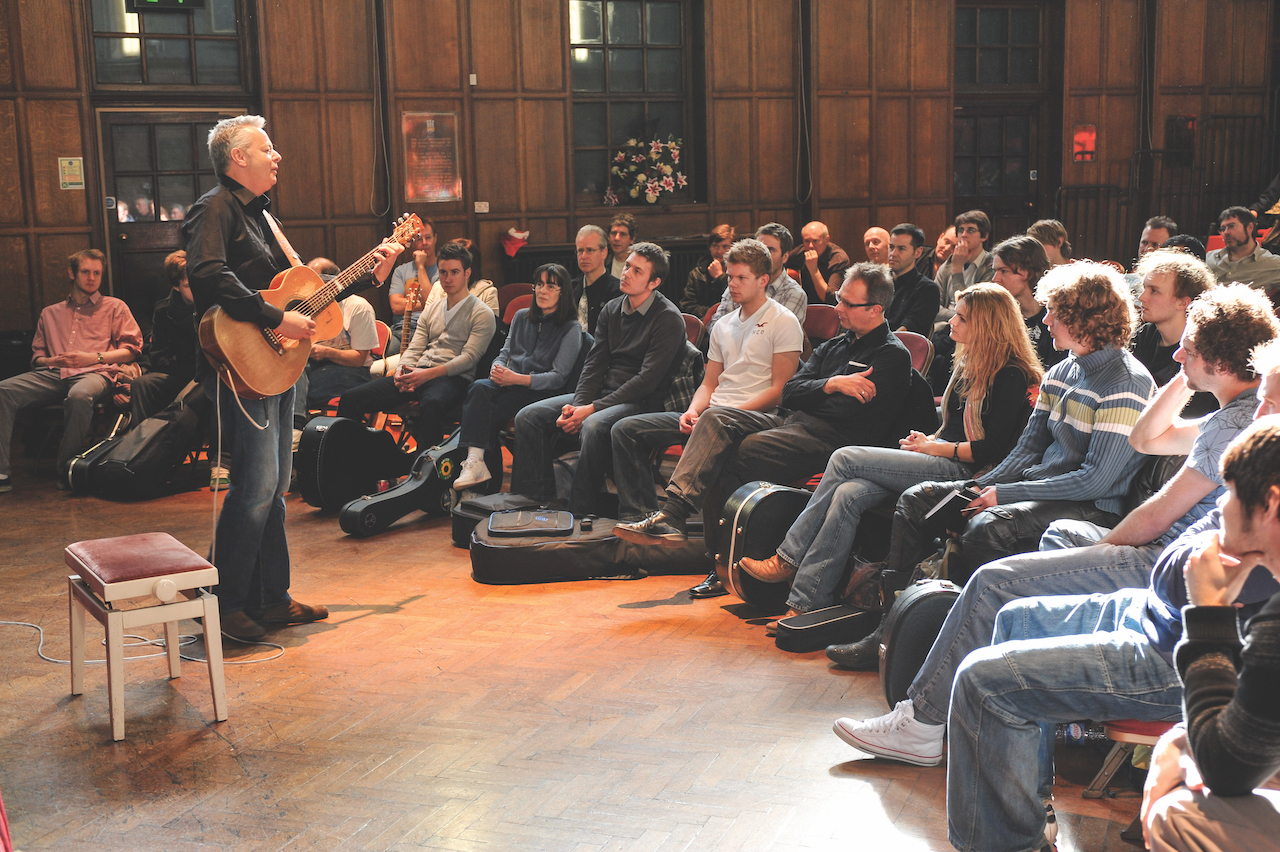
Tommy Emmanuel has been a working professional musician from the somewhat staggering age of six, when he toured his native Australia playing rhythm guitar in his family’s band, living on the road in their cars and rarely going to school. He was inspired to play after hearing the Travis picking style of Chet Atkins on the radio, a lightbulb moment and one that he still remembers vividly.
Six decades on, Tommy is widely regarded as one of the world’s finest acoustic fingerstyle players, a guitarist whose emotive playing and impeccable feel are matched by his sublimely dextrous technique. He sets the bar high for himself, and his incendiary live shows regularly wow audiences in venues across the globe.
Who better, then, to offer advice on how to hone your technique, your creative processes, and your entire mental attitude when venturing out to the studio and the live circuit?

Once you’ve got some material together and you’re thinking about going into the studio, what do you do to make sure that, when you start tracking, you’re able to freely express yourself with the music?
“Well, it’s all about the homework you’ve already done. I have to be absolutely be in love with the song and know that this is a song that I want to record. I write songs and record them on my iPhone and that’s my demo. That song, in every way, has to stand up and once I’m certain of that, then when I go to the studio, I’m in heaven.
“It’s really all about the quality of the music and your belief that everything about the song is as strong as you can get it. Once I feel that every part, every minute detail, is right and that the song does what I need it to do, it satisfies me in every way, once I’m certain of that, then okay, ‘Boom!’ I’m ready to go. My guitar’s got good strings on it, it’s in tune, we’ve got good microphones, I’m wearing headphones, I can hear a little reverb or whatever. I’ve got the sound of my dreams in my ears.
“Now I’m going to play the song to the best of my abilities, with the best time, the best feeling. That’s really the bottom line. I never go into the studio unprepared.”
What do you do if or when you encounter a phrase that will make the strings squeak?
“You know what? All arrangements have that in them. What you’ve got to do is practice a lot more. You’ve got to play that thing a thousand times until you iron out all the noises, until you can play it fluidly, so it just flows along. There are no shortcuts or easy ways. There’s only getting it right.”
There’s always the one track, especially if you’re playing it live, where you think, ‘Oh, this is the really tricky one, this is the one that’s got that long stretch that sometimes trips me up.’ Is that just a case of focusing as well, or do you rewrite your way around it?
“If there’s a song I’ve written and there’s a part in it that I don’t really feel 100 per cent about, I usually get rid of it. I usually write something else that’s better. I never think, ‘Oh, I’m writing a fingerstyle song.’ I always think I’m trying to write the best song I can with this idea I’ve got. So I never feel constrained by being a solo player.
“I always imagine that I’m trying to write a hit record. I’m trying to write something that I want to hear over and over: that’s the feeling we’re looking for. How many thousands and thousands of times have I heard Penny Lane? But I could hear it again right now because that song does it for me.”
Some acoustic guitars feel like they really tend to love certain tunings. Do you keep guitars for particular tunings?
“I have three basic guitars with three different tunings. My main guitar, that I use on stage, is always in normal tuning; I don’t play anything at all in DADGAD. I have another guitar with bigger strings on it that is tuned down a whole step. Then I usually do it in drop D so it’s down to C and I play ballads and tunes that I’ve written with that lower, more beautiful-sounding tuning. And then the third guitar is a real traditional-sounding cutaway that I usually use the G6 tuning [for] or just drop D.
If you want to do what I’m doing, you’d better be prepared to be naked on stage because there’s nowhere to hide
“The other thing is that I’m a touring concert artist, so I’ve got to say everything that I want to say in an hour and a half maximum and I’ve got to give it hell, give people the best time of their lives, play the best I can, keep it interesting, keep the tones interesting, make sure I’m perfectly in tune, I’m perfectly in time. So if a guitar is not doing it for me, I just leave it at home; find the ones that do.”
What advice do you have for those who are new to the stage as solo fingerstyle acoustic guitarists? If you’ve always been in bands with electric guitars, for example, you’ve got quite a lot of cover there, haven’t you?
“Exactly [laughs]. Well, that’s why I tell people, ‘If you want to do what I’m doing, you’d better be prepared to be naked on stage because there’s nowhere to hide.’ Everything is exposed. So if you want to be doing well at that, you’d better get to work on it. You better do it a lot, find all the weak spots and get rid of them.
“I need my guitar to be awesome every single time I walk on stage. I need my tuning to be the greatest, the most in tune that satisfies my really picky ear, all that sort of stuff. You know what works and you’re always diligent about your tuning, your strings, your action and then your material choice.”
When you’ve got a flowing piece of fingerstyle acoustic to play, every single piece is essential. So if you fluff one section, it feels like there’s no safety net there. Is the only strategy to that to just routine it as often as possible in front of people and drive out those demons of doubt?
“Yeah, that’s it. I mean, the truth is, we’re not machines. So some days I play things better than I played the last time I played it. And I don’t know why that is. And there are some days where I think, ‘Oh God, I feel like I’ve got lead in my fingers, I’m playing so slow.’ Then I watch a video of that very same performance a week later and it’s fast as hell. It was my perspective on it at that moment.
Be honest with your audience. Every day I’m nervous, but… there’s no judge and jury out there, they’re all in your head
“We vary. What I aim for is trying to be consistent. You know, trying to, even on my worst day, still play something that gives people a great time [so] that hopefully, people won’t sense that I’m struggling or that I’m not in the zone.
“So much of it is about what’s going on in our minds and that’s a dangerous area. If I let my mind wander, that’s a bad thing: I’m playing a song and [I think], ‘Have I played two bridges or have I played three choruses, not two?’ You can’t let that happen. You’ve got to find a way of staying absolutely 100 percent present when you’re playing.”

There are going to be days when you feel like you’re grinding through something, even if other people don’t detect it, and then the days when everything flows and you just cannot make a mistake. It’s literally like you’re better than your best day, which is a battle as well…
“[Laughs] The older I get, the more I go, ‘Oh man, it was the most incredible night. Oh shit, now we gotta try and top it again tomorrow night. How are we gonna do that?’ And you’ve just got to know that you’re human. There’s gonna be cracks and there’s gonna be days when you make the most stupid mistakes because you got cocky or because you stopped being 100 percent concentrated. It’s just part of being a human being.
“So, I try to make that happen as [little] as possible, you know? And try not to get angry at myself. What I’ve got to do is say, ‘Right, here’s why. All right, I accept that. Now, tomorrow I’m gonna try harder.’ And that’s all I can do.”
The reassuring thought with music is that, at the end of the day, if you’re a guitarist and you screw up, everyone moves on.
“Well, exactly. I mean, there are times, if things are not going well, I’ll sit and tell the audience that I’m struggling or that, you know, ‘I came out here full of vim and vigor and now I’m really struggling. But I’m going to tell you this because it makes me feel better that I’m honest with you. And that I’m just human like everybody else. So let me try this.’ And I’ll play something else and people will applaud and people will be with you.
“That’s why I always tell students, when you go on stage, you’d better be honest with your audience. And every day I’m nervous, but I’m going to do the best I can and everybody will be with you. There’s no judge and jury out there, they’re all in your head.”
- Tommy Emmanuel’s latest album, Accomplice Two, is out now on Slimstyle Records. For more info and tour dates, see his official website.







